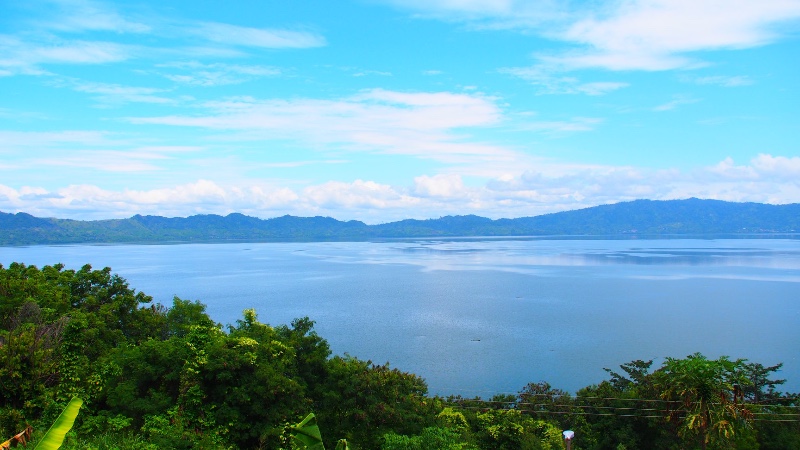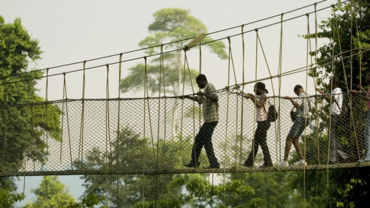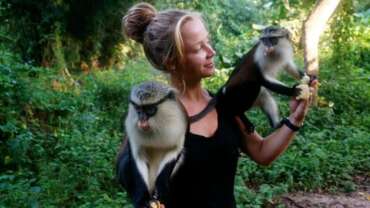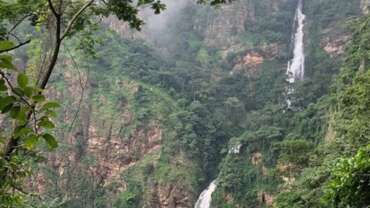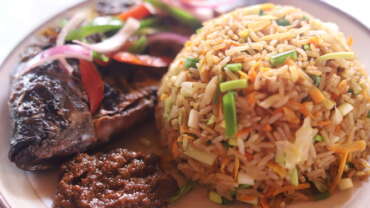Experiences in Ghana
Eco Tourism
Lake Bosomtwi – The only true inland lake in the country located in the Ashanti region. It is an awesome place to relax and enjoy nature. The lake has no surface outlet and was formed in a meteorite impact crater with an area of 19 square miles (49 square km) and a depth of 230–240 feet (70–73 metres), The lake is surrounded by lush mountains and fed by small streams that tumble down the crater’s steep sides (500–1,400 feet [150–425 metres] above water level).
Situated in the Ashanti region of Ghana, Lake Bosomtwe is one of six UNESCO designated biosphere reserve sites. It is one of three of such internationally recognized sites in the country – Bia in the Western, and Songhor in Greater Accra Region.
Tafi-Atome Monkey Sanctuary – For the past 200 years, the Mona monkeys inhabiting the tropical forest surrounding the small village of Tafi-Atome have been protected because it was believed they were messengers to the gods. In 1996, the village began broader efforts to protect their forest and monkeys, as well as to offer tours for visitors.
As a result of these efforts, the monkey population has increased to about 200 and the forest, with its many species of birds and butterflies, has been preserved. The playful monkeys are wild but often come down very close to visitors. Revenue from tourism has brought electricity to the village, as well as improvements to the school and a community clinic.
Wli Waterfalls – Wli Waterfalls (pronounced ‘vlee’), also called Agumatsa Falls, is a popular and dramatic tourist site near the village of Wli not far from the Togo border. Most tourist make the easy walk to the lower falls, which is mostly a flat trail but stunning and beautiful in setting, made even more dramatic by the presence of thousands of fruit bats nesting high up on the nearby cliffs. However, the equally high and much more isolated upper falls is a special treat for those with the stamina for the challenging hike. There are inviting pools at the base of both falls where the hearty can take a chilly dip.
The Wli waterfalls is the highest water fall in West Africa. The falls is known locally as Agumatsa waterfalls – meaning, “Allow Me to Flow.” It is located in the Hohoe municipality of the Volta Region, the land of the Ewe culture. It is approximately 280 kilometers from the capital Accra. The walk take you through the Agumatsa Wildlife Sanctuary, which features more than 200 bird species and 400 butterfly species.
Boti Falls – Boti falls is a twin waterfall located at Boti in the Eastern Region of Ghana. Boti falls takes its course from a river known locally as Ponmpon. History has it that the fall was hidden in the forest until it was discovered by a white Catholic priest. There are actually two falls at Boti: The upper falls and the lower falls.
Boti is a seasonal falls is a double side-by-side falls during the high flow and at the bottom of 250 concrete steps. During full flow you are surrounded in a canyon of falling water. It can be found in the forest of Huhunya. The larger one is mythically believed to be the male and the smaller one the female. According to the local folks, when the two merge, a rainbow is formed. It is usually said that these rivers are mating when this happens.
A visit to Boti is actually a three-in-one pack: the umbrella rock, the three-headed palm tree and, of course, the falls themselves. It is the most visited falls in the Eastern Region.
Nzulezu stilt village – Near the coast at the far western side of Ghana, near the border with Cote d’Ivoire, is a village that is unique in all of Ghana. Spectacular scenery of the 400-year old stilt propped water settlement of Nzulezu, is a unique village built on stilts in Lake Tadane, which is home to hundreds of people in the Western Region.
Nzulezu is an Nzema word meaning ‘surface of water’. The inhabitants of the village are said to have migrated from Walata, a city in the ancient Ghana Empire, the earliest of the Western Sudanese States. According to tradition, ancestors of the village were brought to their present place by a snail.
The serene ambiance of the surrounding landscape, coupled with the general activities of life on stilts points to a dynamic relationship between man and nature. It is essentially one long pier, called Main Street by the locals, with buildings constructed on both sides. One side of the ‘street’ are living quarters while the other side of the street has businesess, the school, a community center and other commercial ventures.
EVENTS & FESTIVALS
Centuries of old traditions of the people of Ghana and the diversity of the distinct ethnic groups have created a rich culture that is the splendid legacy of modern Ghana. To the people of Ghana the traditions of their ancestors are still an important part of their daily life. Traditional chiefs have historical authority over tribal and family matters. They are also custodians of land belonging to their respective clans or groups.
Important events such as child naming, puberty initiations, marriage and death are marked by rites and rituals at family gathering, while seasonal festivals bring a whole people or clan together in spectacular fashion.
A common feature is the belief of life after death and in the nearness of dead ancestors. Festivals also recall past events and consecrate a new season with confidence and hope.
Ghana’s diverse culture is depicted through its many exciting festivals which are held throughout the year. The festivals and the ceremonies reflect the rich diversity of history and culture of tribal life in the regions.
Many festivals include thrilling durbars of chiefs and people when tribal leaders and Queen Mothers ride in decorated palanquins, shaded by traditional umbrellas, and supported by drummers and warriors discharging ancient muskets and cheered by people.
Thousands of people including foreigners from all walks of life travel all over the country to witness the festivals which are celebrated almost every week throughout the year.
BEACH AND RESORTS
Clearly, one of the main attractions of this West African country is its opulent, picturesque beaches. The coastline of Ghana was previously known as The Gold Coast and one can immediately see why. The majority of these spectacular sands are kept in Accra; where all different tastes can be suited.
If you want a more traditional beach experience then perhaps the best would be the Labadi Pleasure Beach. An entrance fee must be paid for this particular experience which might detract slightly from the enjoyment, but for your money you get one of the few beaches in Ghana which is deliberately kept clean, a plethora of restaurants and bars to avail yourself of and, on certain days, performances of cultural music and dancing; mainstream music is often also available to enjoy as well.
Ghana also boasts much more secluded, tranquil beaches. For example, Misty Beach, to be found as one leaves Accra on the way to Tema, is great for getting off the tourist-track. Whether you want to watch the army’s of fishermen leave every morning, or simply relax in the solitude lacking on larger beaches such as Labadi, this could be a great choice.
If you like a more environmental and nature-filled slant on your beach experience, then Cocoloco Beach could be ideal. About an hour’s travel out of Accra, it marks the point where the Volta River merges into the Atlantic Ocean; creating a wonderful natural environment which has become renown for the large variety of sea turtles which breed there, as well as the huge variety of birds which can be seen in the Volta Estuary. Sticking with the Volta, the Ada beach is another such sand which merges with the river and provides spectacular, unrivalled views. If spectacular views are what you’re after, then the Kokrobrite Beach, about 30 kilometres outside of Accra, might also interest you. Its serenity is offset by dramatic hills which provide a frame to the large beach; another must for those who like to have their breath taken away.
For those who want to escape even further there is the quite ironically named Alaska Beach which is on the shore of the Gulf of Guinea. It offers a chance to escape the constant on-the-go feeling of the more touristy spots, but doesn’t leave you completely in the wild, with showers, camping facilities and even provision Ghanaian food on demands.
NATIONAL MONUMENTS
The castles and forts of Ghana constitute treasures par excellence, a legacy of the historic past as much to modern Ghana and Africa as to the world at large.
Though built on African soil, their authors came from Europe – Portuguese, Dutch, French, Britons, Brandenburg-Prussians, Danes and Swedes.
For several centuries, European masters and native African servants lived and worked in them. The warehouses teemed with gold and ivory export products as well as African slaves destined for auction in the New World, there to become ancestors to future generations of black populations.
Indeed, these historic buildings were no respectors of persons and extraordinary history was made once when one castle, Elmina, held prisoner an Asante King in all his splendour during the first stage of his forced exile from Ghana.
Hence, not only modern Ghanaians, but also many millions in countries of the Western hemisphere and elsewhere constitute stake-holders with an interest in ensuring the preservation of these historic castles and forts.
Recognizing their unique place in world history, the World Heritage Convention of UNESCO has designated Ghana”s castles and forts as World Heritage Monuments.



